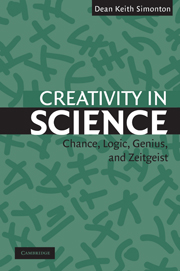Book contents
- Frontmatter
- Contents
- Preface
- Mathematical Notation
- Chapter 1 Introduction: Scientific Creativity
- Chapter 2 Creative Products
- Chapter 3 Combinatorial Processes
- Chapter 4 Scientific Activity
- Chapter 5 Creative Scientists
- Chapter 6 Scientific Discovery
- Chapter 7 Consolidation: Creativity in Science
- References
- Index
Chapter 1 - Introduction: Scientific Creativity
Published online by Cambridge University Press: 05 June 2012
- Frontmatter
- Contents
- Preface
- Mathematical Notation
- Chapter 1 Introduction: Scientific Creativity
- Chapter 2 Creative Products
- Chapter 3 Combinatorial Processes
- Chapter 4 Scientific Activity
- Chapter 5 Creative Scientists
- Chapter 6 Scientific Discovery
- Chapter 7 Consolidation: Creativity in Science
- References
- Index
Summary
Consider the following list: Newton's Principia Mathematica, Plato's Republic, Shakespeare's Hamlet, da Vinci's Last Supper, and Beethoven's Fifth Symphony. What do these items have in common? The answer clearly is that all five represent creative products, even works of genius. Each can be considered an exemplary contribution to a particular domain of creative achievement. Each of these creations exerted a profound and pervasive influence on the collective repository of human accomplishments that defines world civilization.
Yet in one crucial respect, one of the items on this list does not belong with the rest: Newton's scientific masterpiece. Unlike the others, it is the single work whose merits as a creative product cannot be reasonably assessed by an educated layperson. Any literate person can pull a copy of Republic or Hamlet off the library shelf and obtain at least some understanding of the logical argument or dramatic development. Likewise, anyone can look at a print of the Last Supper or listen to a recording of the Fifth Symphony and obtain a good notion of what was being graphically conveyed or musically expressed.
In contrast, it would be rare to find a layperson who could make any sense of the Principia Mathematica. Even modern mathematicians and physicists find it tough going, given its obsolete notation and presentational style. Worse still, few people these days read Newton's masterwork for either pleasure or edification. It has become a museum piece largely doomed to collect dust on the bookshelf.
- Type
- Chapter
- Information
- Creativity in ScienceChance, Logic, Genius, and Zeitgeist, pp. 1 - 13Publisher: Cambridge University PressPrint publication year: 2004



